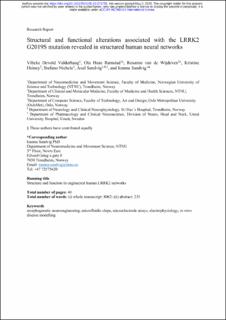| dc.contributor.author | Valderhaug, Vibeke Devold | |
| dc.contributor.author | Huse Ramstad, Ola | |
| dc.contributor.author | van de Wijdeven, Rosanne Francisca | |
| dc.contributor.author | Heiney, Kristine | |
| dc.contributor.author | Nichele, Stefano | |
| dc.contributor.author | Sandvig, Axel | |
| dc.contributor.author | Sandvig, Ioanna | |
| dc.date.accessioned | 2021-03-24T09:54:35Z | |
| dc.date.available | 2021-03-24T09:54:35Z | |
| dc.date.created | 2020-05-06T12:12:18Z | |
| dc.date.issued | 2020 | |
| dc.identifier.citation | BioRxiv. 2020, . | en_US |
| dc.identifier.issn | 0362-4331 | |
| dc.identifier.uri | https://hdl.handle.net/11250/2735246 | |
| dc.description.abstract | Mutations in the LRRK2 gene have been widely linked to Parkinson’s disease. The G2019S variant has been shown to contribute uniquely to both familial and sporadic forms of the disease. LRRK2-related mutations have been extensively studied, yet the wide variety of cellular and network events directly or indirectly related to these mutations remain poorly understood. In this study, we structured multi-nodal human neural networks carrying the G2019S mutation using custom-designed microfluidic chips coupled to microelectrode-arrays. By applying live imaging approaches, immunocytochemistry and computational modelling, we have revealed alterations in both the structure and function of the resulting neural networks when compared to controls. We provide first evidence of increased neuritic density associated with the G2019S LRRK2 mutation, while previous studies have found either a strong decrease, or no change, compared to controls. Additionally, we corroborate previous findings regarding increased baseline network activity compared to control neural networks. Furthermore, we can reveal additional network alterations attributable to the specific mutation by selectively inducing transient overexcitation to confined parts of the structured multi-nodal networks. These alterations, which we were able to capture both at the micro- and mesoscale manifested as differences in relative network activity and correlation, as well as in mitochondria activation, neuritic remodelling, and synaptic alterations. Our study thus provides important new insights into early signs of neural network pathology significantly expanding upon the current knowledge relating to the G2019S Parkinson’s disease mutation. | en_US |
| dc.language.iso | eng | en_US |
| dc.publisher | BioRxiv | en_US |
| dc.rights | Attribution-NonCommercial-NoDerivatives 4.0 Internasjonal | * |
| dc.rights.uri | http://creativecommons.org/licenses/by-nc-nd/4.0/deed.no | * |
| dc.title | Structural and functional alterations associated with the LRRK2 G2019S mutation revealed in structured human neural networks | en_US |
| dc.type | Journal article | en_US |
| dc.description.version | submittedVersion | en_US |
| dc.source.pagenumber | 27 | en_US |
| dc.source.journal | BioRxiv | en_US |
| dc.identifier.doi | https://doi.org/10.1101/2020.05.02.073726 | |
| dc.identifier.cristin | 1809644 | |
| dc.relation.project | Samarbeidsorganet mellom Helse Midt-Norge og NTNU: x | en_US |
| dc.relation.project | Norges forskningsråd: 270961 | en_US |
| dc.relation.project | Regionale forskningsfond Midt-Norge: x | en_US |
| cristin.ispublished | true | |
| cristin.fulltext | original | |

